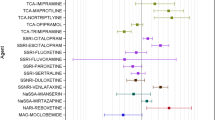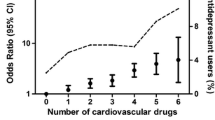Abstract
Purpose
The study aimed to fill existing knowledge gaps on the safety of antidepressant drugs (ADs) by estimating the risk of hospitalization for arrhythmia associated with use of selective serotonin reuptake inhibitors (SSRIs) and newer atypical ADs (NAAs) among elderly with previous cardiovascular (CV) events.
Methods
The cohort was composed by 199,569 individuals aged ≥ 65 years from five Italian healthcare territorial units who were discharged for cardiovascular outcomes in the years 2008–2010. The 17,277 patients who experienced hospital admission for arrhythmia during follow-up were included as cases. Odds of current ADs use among cases (i.e., 14 days before hospital admission) was compared with (i) odds of current use of 1:5 matched controls (between-patients case-control) and with (ii) odds of previous use during 1:5 matched control periods (within-patient case-crossover). The risk of arrhythmia associated with ADs current use was modelled fitting a conditional logistic regression. A set of sensitivity analyses was performed to account for sources of systematic uncertainty.
Results
Current users of SSRIs and NAAs were at increased risk of arrhythmia with case-control odds ratios (OR) of 1.37 (95% confidence interval, CI 1.18 to 1.58) and 1.41 (1.16 to 1.71) and case-crossover OR of 1.48 (1.20 to 1.81) and 1.72 (1.31 to 2.27). An increased risk of arrhythmia was associated with current use of trazodone (NAA) consistently in case-control and case-crossover designs.
Conclusions
Evidence that current use of SSRIs and NAAs is associated to an increased risk of arrhythmia among elderly with CV disease was consistently supplied by two observational approaches.



Similar content being viewed by others
References
Depression. A global public health concern. Available at: http://www.who.int/mental_health/ (last accessed 15 March 2017)
Brinda EM, Rajkumar AP, Attermann J, Gerdtham UG, Enemark U, Jacob KS (2016) Health, social, and economic variables associated with depression among older people in low and middle income countries: World Health Organization Study on Global AGEing and Adult Health. Am J Geriatr Psychiatry 24:1196–1208
Biffi A, Scotti L, Corrao G (2017) Use of antidepressants and the risk of cardiovascular and cerebrovascular disease: a meta-analysis of observational studies. Eur J Clin Pharmacol 73:487–497
Shin D, Oh YH, Eom CS, Park SM (2014) Use of selective serotonin reuptake inhibitors and risk of stroke: a systematic review and meta-analysis. J Neurol 261:686–695
Waring WS (2012) Clinical use of antidepressant therapy and associated cardiovascular risk. Drug Healthc Patient Saf 4:93–101
Wenzel-Seifert K, Wittmann M, Haen E (2011) QTc prolongation by psychotropic drugs and the risk of Torsade de Pointes. Dtsch Arztebl Int 108:687–693
Bavle A (2015) Venlafaxine induced QTc interval prolongation in a therapeutic dose. Asian J Psychiatr 16:63–64
Isbister GK (2009) Electrocardiogram changes and arrhythmias in venlafaxine overdose. Br J Clin Pharmacol 67:572–576
El-Sherif N, Turitto G (2003) Torsade de pointes. Curr Opin Cardiol 18:6–13
Howland RH (2011) A critical evaluation of the cardiac toxicity of citalopram: part 2. J Psychosoc Nurs Ment Health Serv 49:13–16
Coupland C, Hill T, Morriss R, Moore M, Arthur A, Hippisley-Cox J (2016) Antidepressant use and risk of cardiovascular outcomes in people aged 20 to 64: cohort study using primary care database. BMJ 352
Charlson ME, Charlson RE, Peterson JC, Marinopoulos SS, Briggs WM, Hollenberg JP (2008) The Charlson comorbidity index is adapted to predict costs of chronic disease in primary care patients. J Clin Epidemiol 61:1234–1240
Albrecht CA (2004) Proarrhythmia with non-antiarrhythmics. A review. Cardiology 102:122–139
Belardinelli L, Antzelevitch C, Vos MA (2003) Assessing predictors of drug-induced torsade de pointes. Trends Pharmacol Sci 24:619–625
Frommeyer G, Eckardt L (2016) Drug-induced proarrhythmia: risk factors and electrophysiological mechanisms. Nat Rev Cardiol 13:36–47
Haverkamp W, Breithardt G, Camm AJ, Janse MJ, Rosen MR, Antzelevitch C, Escande D, Franz M, Malik M, Moss A, Shah R (2000) The potential for QT prolongation and pro-arrhythmia by non-anti-arrhythmic drugs: clinical and regulatory implications. Report on a Policy Conference of the European Society of Cardiology. Cardiovasc Res 47:219–233
Kannankeril P, Roden DM, Darbar D (2010) Drug-induced long QT syndrome. Pharmacol Rev 62:760–781
Poluzzi E, Raschi E, Diemberger I, De Ponti F (2017) Drug-induced arrhythmia: bridging the gap between pathophysiological knowledge and clinical practice. Drug Saf 40:461–464
De Ponti F, Poluzzi E, Cavalli A, Recanatini M, Montanaro N (2002) Safety of non-antiarrhythmic drugs that prolong the QT interval or induce torsade de pointes: an overview. Drug Saf 25:263–286
Yap YG, Camm AJ (2003) Drug induced QT prolongation and torsades de pointes. Heart 89:1363–1372
Konstantopoulou A et al (2013) Mechanisms of drug-induced proarrhythmia in clinical practice. World J Cardiol 5:175–185
Corrao G, Botteri E, Bagnardi V et al (2005) Generating signals of drug-adverse effects from prescription databases and application to the risk of arrhythmia associated with antibacterials. Pharmacoepidemiol DS 14:31–40
Delaney JA, Suissa S (2009) The case-crossover study design in pharmacoepidemiology. Stat Methods Med Res 18:53–65
Higgins JPT, Thompson SG (2002) Quantifying heterogeneity in a meta-analysis. Statist Med 21:1539–1558
C.J. Spindelegger, K. Papageorgiou, R. Grohmann, R. Engel, W. Greil, A. Konstantinidis et al (2014) Cardiovascular adverse reactions during antidepressant treatment: a drug surveillance report of German-speaking countries between 1993 and 2010. Int J Neuropsychopharmacol 18
Jolly K, Gammage MD, Cheng KK, Bradburn P, Banting MV, Langman MJ (2009) Sudden death in patients receiving drugs tending to prolong the QT interval. Br J Clin Pharmacol 68:743–751
Wu CS, Tsai YT, Hsiung CA, Tsai HJ (2017) Comparative risk of ventricular arrhythmia and sudden cardiac death across antidepressants in patients with depressive disorders. J Clin Psychopharmacol 37:32–39
Leonard CE, Bilker WB, Newcomb C, Kimmel SE, Hennessy S (2011) Antidepressants and the risk of sudden cardiac death and ventricular arrhythmia. Pharmacoepidemiol Drug Saf 20:903–913
Weeke P, Jensen A, Folke F, Gislason GH, Olesen JB, Andersson C et al (2012) Antidepressant use and risk of out-of-hospital cardiac arrest: a nationwide case-time-control study. Clin Pharmacol Ther 92:72–79
Danielsson B, Collin J, Jonasdottir Bergman G, Borg N, Salmi P, Fastbom J (2016) Antidepressants and antipsychotics classified with torsades de pointes arrhythmia risk and mortality in older adults—a Swedish nationwide study. Br J Clin Pharmacol 81:773–783
Maljuric NM, Noordam R, Aarts N, Niemeijer MN, van den Berg ME, Hofman A, Kors JA, Stricker BH, Visser LE (2015) Use of selective serotonin re-uptake inhibitors and the heart rate corrected QT interval in a real-life setting: the population-based Rotterdam Study. Br J Clin Pharmacol 80:698–705
Witchel HJ, Hancox JC, Nutt DJ (2003) Psychotropic drugs, cardiac arrhythmia, and sudden death. J Clin Psychopharmacol 23:58–77
Sultana J, Spina E, Trifirò G (2015) Antidepressant use in the elderly: the role of pharmacodynamics and pharmacokinetics in drug safety. Expert Opin Drug Metab Toxicol 11:883–892
Beach SR, Kostis WJ, Celano CM, Januzzi JL, Ruskin JN, Noseworthy PA, Huffman JC (2014) Meta-analysis of selective serotonin reuptake inhibitor-associated QTc prolongation. J Clin Psychiatry 75:e441–e449
Zemrak WR, Kenna GA (2008) Association of antipsychotic and antidepressant drugs with Q-T interval prolongation. Am J Health Syst Pharm 65:1029–1038
Pelat M, Verwaerde P, Tran MA, Berlan M, Senard JM, Montastruc JL (2001) Changes in vascular alpha 1- and alpha 2-adrenoceptor responsiveness by selegiline treatment. Fundam Clin Pharmacol 15:239–245
De Ponti F, Poluzzi E, Montanaro N (2001) Organising evidence on QT prolongation and occurrence of Torsades de Pointes with non-antiarrhythmic drugs: a call for consensus. Eur J Clin Pharmacol 57:185–209
Arizona Center for Education on Research on Therapeutics. Credible meds. Available at: https://www.crediblemeds.org./ (last accessed 12 May 2017)
Strom BL (2000) Overview of automated databases in pharmacoepidemiology. In: Strom BL (ed) Pharmacoepidemiology, 3rd edn. Wiley, Chichester, UK, pp 219–222
Ray WA (2003) Evaluating medication effects outside of clinical trials: new-user designs. Am J Epidemiol 158:915–920
Tamariz L, THarkins T, Nair V (2012) A systematic review of validated methods for identifying ventricular arrhythmias using administrative and claims data. Pharmacoepidemiol DS 21(S1):148–153
Romano PS, Mark DH (1994) Bias in the coding of hospital discharge data and its implications for quality assessment. Med Care 32:81–90
Steiner JF, Prochazka AV (1997) The assessment of refill compliance using pharmacy records: methods, validity, and applications. J Clin Epidemiol 50:105–116
Hosker C, Ward D (2017) Hypoactive delirium. BMJ 357:j2047
Kalish VB, Gillham JE, Unwin BK (2014) Delirium in older persons: evaluation and management. Am Fam Physician 90:150–158
Booth-Kewley S, Friedman HS (1987) Psychological predictors of heart disease: a quantitative review. Psychol Bull 101:343–362
Frasure-Smith N, Lespérance F, Talajic M (1993) Depression following myocardial infarction: impact on 6-month survival. JAMA 270:1819–1825
Frasure-Smith N, Lespérance F, Talajic M (1995) Depression and 18-month prognosis after myocardial infarction. Circulation 91:999–1005
Wiśniowska B, Tylutki Z, Wyszogrodzka G, Polak S (2016) Drug-drug interactions and QT prolongation as a commonly assessed cardiac effect—comprehensive overview of clinical trials. BMC Pharmacol Toxicol 17:12
Acknowledgements
This study was funded by a research grant from the AIFA—the Italian Medicines Agency (AIFA, project AIFA-FARM9LBBBL), Rome, Italy. Data analyses were performed at the Laboratory of Healthcare Research & Pharmacoepidemiology, Department of Statistics and Quantitative Methods, University of Milano-Bicocca with grants from the Italian Ministry of Education, University and Research (“Fondo d’Ateneo per la Ricerca” portion, year 2015).
I-GrADE members: Nera Agabiti, Claudia Bartolini, Roberto Bernabei, Alessandra Bettiol, Stefano Bonassi, Achille Patrizio Caputi, Silvia Cascini, Alessandro Chinellato, Francesco Cipriani, Giovanni Corrao, Marina Davoli, Massimo Fini, Rosa Gini, Francesco Giorgianni, Ursula Kirchmayer, Francesco Lapi, Niccolò Lombardi, Ersilia Lucenteforte, Alessandro Mugelli, Graziano Onder, Federico Rea, Giuseppe Roberto, Chiara Sorge, Michele Tari, Gianluca Trifirò, Alfredo Vannacci, Davide Liborio Vetrano, Cristiana Vitale
Author Contributions
GC generated the study idea and wrote the final manuscript. AB performed all statistical analyses. All authors abstracted the data, authorized their utilization, and contributed to their interpretation and to the final manuscript by approving the final version.
Author information
Authors and Affiliations
Consortia
Corresponding author
Ethics declarations
Conflict of interest
EL received research support from the Italian Agency of Drug (AIFA).
AM received research support from the Italian Agency of Drug (AIFA), the Italian Ministry for University and Research (MIUR), Gilead, and Menarini. In the last 2 years, he received personal fees as speaker/consultant from Menarini Group, IBSA, Molteni, Angelini, and Pfizer Alliance. None of these are related to this study.
GT leads an academic pharmacoepidemiology team which runs project that are sponsored by pharmaceutical companies and that are not related to the topic of the paper.
GC received research support from European Community (EC), European Medicine Agency (EMA), Italian Agency of Drug (AIFA), Italian Ministry of Health, and Ministry of Education, University and Research (MIUR). He took part to a variety of projects that were funded by pharmaceutical companies (i.e., Novartis, GSK, Roche, AMGEN, and BMS). He also received honoraria as a member of the Advisory Board from Roche. None of these are related to this study. All other authors declare that they have no conflict of interest.
Electronic supplementary material
ESM 1
(DOCX 20 kb)
Rights and permissions
About this article
Cite this article
Biffi, A., Rea, F., Scotti, L. et al. Antidepressants and the risk of arrhythmia in elderly affected by a previous cardiovascular disease: a real-life investigation from Italy. Eur J Clin Pharmacol 74, 119–129 (2018). https://doi.org/10.1007/s00228-017-2352-x
Received:
Accepted:
Published:
Issue Date:
DOI: https://doi.org/10.1007/s00228-017-2352-x




